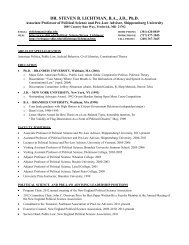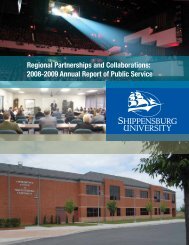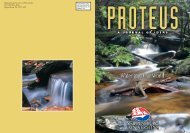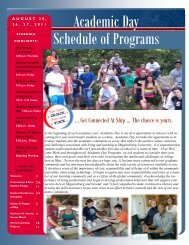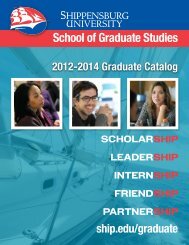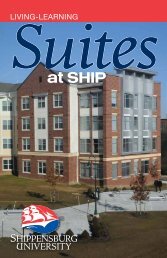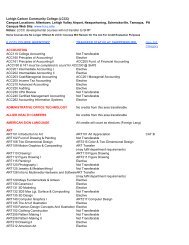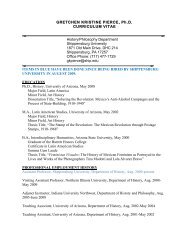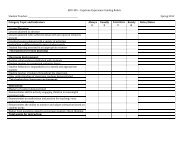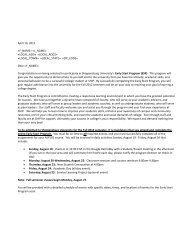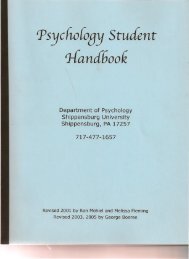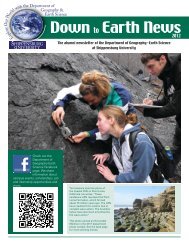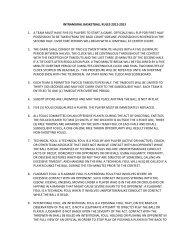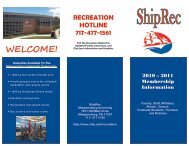2007-2008 Annual Report of Service - Shippensburg University
2007-2008 Annual Report of Service - Shippensburg University
2007-2008 Annual Report of Service - Shippensburg University
You also want an ePaper? Increase the reach of your titles
YUMPU automatically turns print PDFs into web optimized ePapers that Google loves.
38 <strong>Shippensburg</strong> <strong>University</strong><br />
tions for transitioning children. District staff<br />
are invited to visit Head Start classrooms to<br />
encourage awareness <strong>of</strong> curriculum and services<br />
provided to the children. Additionally,<br />
Head Start health staff provides parents with<br />
a School Health <strong>Report</strong>, including child development<br />
information, immunization records<br />
and developmental screening and assessment<br />
results. Special transition meetings involving<br />
district, Intermediate Unit, Head Start staff<br />
and parents are held for children with disabilities<br />
who have an active Individualized<br />
Educational Plan.<br />
Parents receive information regarding<br />
kindergarten registration procedures, and are<br />
invited to accompany their child when Head<br />
Start classes visit a kindergarten classroom<br />
in the spring. The program holds an annual<br />
festival for the transitioning children and their<br />
families, to which school district personnel are<br />
invited, in order to acknowledge this significant<br />
milestone in the child’s life.<br />
The program also provides support to the<br />
parents during their child’s kindergarten year.<br />
Newsletters containing information related to<br />
the public school experience are distributed<br />
on a regular basis during the transition year,<br />
and staff are available to accompany parents<br />
to school meetings and parent-teacher conferences<br />
upon request.<br />
Community Partnerships<br />
Significant, ongoing partnerships with<br />
many local agencies and organization exist<br />
to benefit Head Start Program children<br />
and families. <strong>Service</strong>s are enhanced through<br />
involvement with <strong>Shippensburg</strong> <strong>University</strong><br />
early childhood education, psychology, and<br />
social work faculty and students, Cumberland<br />
and Franklin County Children and Youth<br />
<strong>Service</strong>s agencies, Capital Area and Lincoln<br />
Intermediate Units, community public libraries,<br />
state health <strong>of</strong>fices, the Local Interagency<br />
Coordinating Council, <strong>Shippensburg</strong> Kiwanis<br />
Club, Fort Morris A.A.R.P. Chapter,<br />
<strong>Shippensburg</strong> Human <strong>Service</strong>s Council,<br />
Carlisle United Way’s Success by Six program,<br />
and Christ Among Neighbors, a faith-based<br />
community assistance effort in <strong>Shippensburg</strong>.<br />
The program also coordinates efforts with<br />
neighboring Head Start programs, Capital<br />
Area, Franklin County, and Adams County<br />
to provide services to eligible families living in<br />
the more rural, fringe areas <strong>of</strong> each program’s<br />
service territory.<br />
Male Involvement<br />
Specific efforts have been made to actively<br />
engage fathers in their child’s education<br />
and Head Start experience. A committee<br />
composed <strong>of</strong> several fathers and staff members<br />
met to develop activities which would encourage<br />
participation. A male involvement newsletter<br />
was created and distributed four times<br />
during the year. Several “Father’s Day in the<br />
Classroom” events were held throughout the<br />
spring. The committee developed and sponsored<br />
a popular activity at the annual kindergarten<br />
celebration held in May. Additionally,<br />
the group planned and organized an ongoing<br />
literacy related classroom to home project and<br />
a kite flying event, which is now held annually<br />
in March at a local park. In order to build<br />
upon this initial effort, the committee will<br />
meet regularly to plan future activities which<br />
acknowledge and enhance the unique contributions<br />
that fathers provide to their child’s<br />
education.<br />
Child Outcomes Project<br />
The program implemented a locally designed<br />
ongoing developmental assessment incorporating<br />
all elements defined in the Head<br />
Start Child Outcomes Framework in 2001 as<br />
per Head Start mandates. The assessment system<br />
was designed to assure compliance with<br />
regulations requiring analysis <strong>of</strong> child progress<br />
for groups <strong>of</strong> children over time, minimally,<br />
three times each year. Staff have received<br />
implementation training, and receive ongoing<br />
support throughout the year. Results are utilized<br />
by the education staff in daily planning,<br />
and with parents when developing and revising<br />
individualized goals for children throughout<br />
the operating year.<br />
The data obtained in a paired sample<br />
T-test each year since implementation <strong>of</strong> this<br />
assessment process has shown again this year<br />
that significant gains in all developmental categories<br />
required by the Office <strong>of</strong> Head Start to<br />
be tracked were made by the children at both<br />
the time two and time three assessment.<br />
Additionally, individual items were combined<br />
to obtain overall scores in certain developmental<br />
categories. Again, children scored<br />
significantly higher on the second assessment<br />
in all categories than they did on the first assessment.<br />
As well, children scored significantly<br />
higher on the third assessment in these categories<br />
than they did on the second assessment.<br />
Average Percentage <strong>of</strong> Change from<br />
Time 1 to Time 3<br />
Home-<br />
Based<br />
Children<br />
A. Large Motor<br />
Development<br />
B. Small Motor<br />
Development<br />
C. Cognitive<br />
Development/<br />
Classification/Seriation<br />
D. Cognitive<br />
Development/Number,<br />
Time, Space, Memory<br />
Center-<br />
Based<br />
Children<br />
18% 24%<br />
24.6% 32%<br />
26.8% 35%<br />
24.2% 28.6%<br />
E. Spoken Language 30.8% 32%<br />
F. Written Language<br />
and Book Knowledge<br />
26.2% 34.3%<br />
G. Imagination: Art,<br />
Movement, Dramatic 26.8% 36.3%<br />
Play<br />
H. Science and Health 25.2% 31%<br />
I. Social Development 38.6% 33.3%<br />
J. Emotional<br />
Development<br />
43.2% 35%<br />
Training Events<br />
Staff: Family Partnership Development<br />
and Goal Setting<br />
❚ Mental Health Screening<br />
❚<br />
Conscious Discipline<br />
❚ Ongoing Child Assessment Techniques<br />
and Documentation<br />
❚ Child Abuse and Neglect – Mandated<br />
<strong>Report</strong>ing Issues<br />
❚ Child Nutrition Requirements<br />
❚ Health and Safety: Bloodborne<br />
Pathogens Issues<br />
❚ Infant/Child First Aid and CPR<br />
Parents: Literacy Development/<br />
Kindergarten Readiness<br />
❚ Family Nutrition<br />
❚<br />
❚<br />
❚<br />
❚<br />
Infant/Child First Aid and CPR<br />
Child Abuse and Neglect<br />
Life Skills/ Job Seeking Skills<br />
G.E.D. Skills Development<br />
❚ Program Governance Issues:<br />
Parliamentary Procedures,<br />
❚ Program Budget Development,<br />
❚<br />
Policy and Procedure Development,<br />
❚ Human Resource Management/Policies,<br />
Program Self-Assessment



